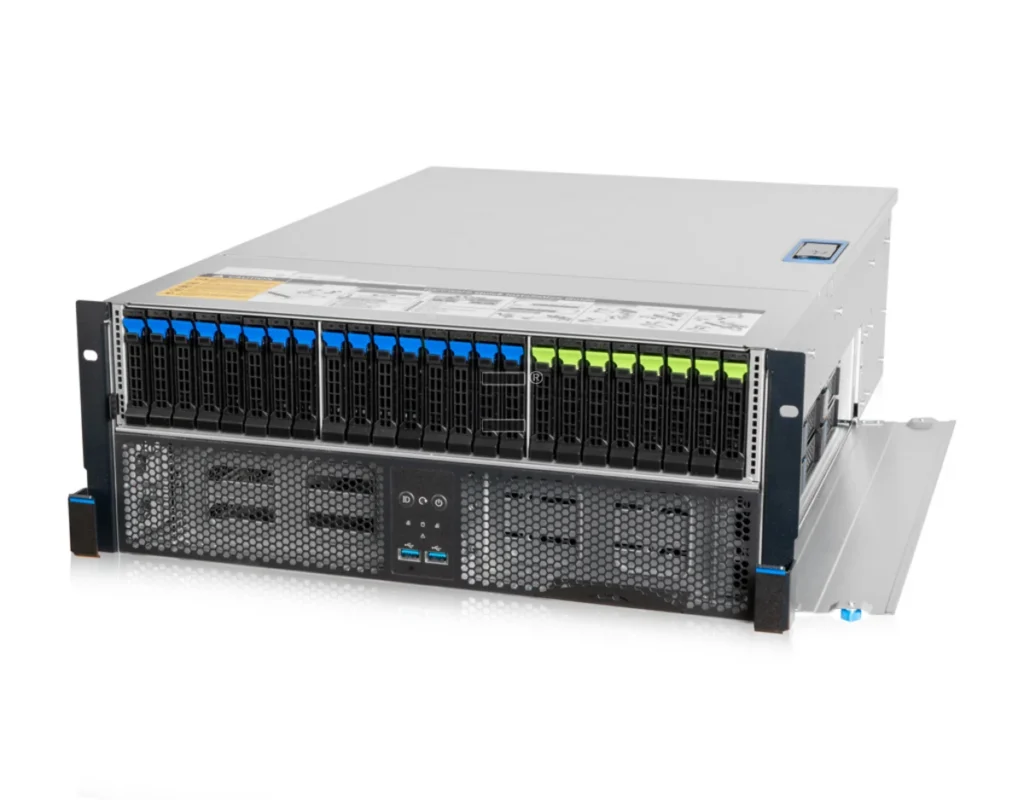Intel’s 5th-Gen Xeon “Emerald Rapids” Revolutionizes Server Performance
In December 2023, Intel introduced its 5th-Generation Xeon Scalable processors, codenamed Emerald Rapids, signaling a pivotal leap forward in server CPU design Intel Download CenterData Center Knowledge. These chips brought to data centers a powerful blend of performance, efficiency, and AI-readiness.

Key Highlights:
- Stocks and Specs: Emerald Rapids supports up to 64 cores, delivering roughly 40% higher overall performance compared to its predecessor, Sapphire Rapids Data Center KnowledgeWikipedia.
- Performance Metrics: Intel cites 21% gains in general compute performance, 36% better performance per watt, and 42% improvements in AI inference over previous generations Data Center Knowledge+1.
- AI Acceleration: Built-in AI engines on every core can handle both inference and fine-tuning of models up to 20 billion parameters IntelLenovo Press.
- Efficiency and Sustainability: The chips feature significant power savings, with ServeTheHome noting idle power reductions of up to 90 watts per socket compared to Sapphire Rapids, thanks to internal architectural enhancements Reddit.
- Compatibility & Upgradability: Emerald Rapids maintains socket and BIOS compatibility with its predecessor, allowing organizations to deploy it in existing infrastructure with minimal disruption Boston IndiaLenovo Press.
- Enhanced Memory & I/O: In addition to computational upgrades, the platform supports DDR5 memory (up to 66% more bandwidth vs. DDR4), PCIe 5.0 (up to 80 lanes), and CXL 1.1 to pave the way for next-gen accelerators and memory expansion Intel.

Ecosystem Adoption: Advantech, Lenovo, HPE
Multiple OEMs have already integrated Emerald Rapids into their next-gen server offerings:
- Advantech launched a suite of 12 server platforms based on 5th-Gen Xeon, targeting industrial, AI, edge-computing, and networking workloads. These offer enhanced scalability, workload optimization, and energy efficiency Advantech.
- Lenovo unveiled updates to its ThinkSystem V3 and ThinkAgile lines—including SR650 V3, SR630 V3, SD650 V3, and SD650-I V3—retrofitting them with 5th-Gen Xeon CPUs, up to DDR5-5600 memory support, and even water-cooling options in direct-water-cooled trays Lenovo Press.
- HPE introduced its Synergy 480 Gen11 Compute Module, available globally from February 2024, featuring the new 5th-Gen Xeon processors for composable infrastructure use cases HPE Community.
Conclusion: Emerald Rapids marks an evolutionary—but strategically impactful—update. It boosts compute density, efficiency, and AI capabilities while providing a smooth upgrade path for modern data centers.

Microsoft Azure: Fortifying Security, Expanding AI, and Scaling Cloud Dominance
While Intel reshapes server architecture, Microsoft Azure continues to fortify its cloud infrastructure and AI ecosystem with bold, high-impact innovations.
1. Strengthening Server-Level Security: Azure Integrated HSM
At Hot Chips 2025, Microsoft introduced the Azure Integrated HSM, a custom security ASIC deployed in every Azure server to tackle the global cybercrime threat, now estimated at a staggering $10.2 trillion annually TechRadar.
- Architectural Shift: Moving away from centralized HSM clusters, these chips embed hardware-level cryptographic processing directly on each server. They meet FIPS 140-3 Level 3 standards and provide local tamper-resistant key protection—boosting both security and reducing latency TechRadar.
- Holistic Security Stack: The initiative is part of Microsoft’s comprehensive “Secure by Design” strategy, including features like Azure Boost (isolated control-plane services), Datacenter Secure Control Module enforcing silicon root-of-trust, and Confidential Computing for multi-tenant protection supported by innovations like Caliptra 2.0 with post-quantum cryptography TechRadar.
2. AI Expansion and Strategic Independence
- Microsoft unveiled its in-house AI models, MAI-Voice-1 and MAI-1-preview, the former driving expressive speech for Copilot Daily and Podcasts, while the latter—trained on ~15,000 NVIDIA H100 GPUs—marks Microsoft’s first foundational model fully developed internally Windows Central.
- The move signals a concerted effort to reduce dependency on OpenAI amid rising costs, shifting strategic dynamics between the two giants Windows Central.
3. AI Agents & Developer Tools: Build 2025 Highlights
At Build 2025, Microsoft spotlighted the surging power of agentic AI, with usage of AI agents more than doubling year-over-year Business Insider.
- Features included Azure SRE Agent integrated into GitHub Copilot, enabling it to perform delegated tasks—not just code suggestions.
- Microsoft unveiled Copilot Tuning, allowing enterprise agents to be customized via company-specific data.
- A surprise partnership with xAI (founded by Elon Musk) was announced: Azure AI Foundry will host Grok 3 and Grok 3 mini models, introducing an unfiltered AI model into Azure’s ecosystem The Times of IndiaBusiness Insider.
4. Economic Scale, Market Scrutiny, and Cloud Leadership
- Financial Milestone: Microsoft disclosed for the first time that Azure achieved $75 billion in annual cloud revenue, marking a 34–39% year-over-year growth AP NewsWindows CentralThe Verge.
- Market Cap Achievement: On July 31, 2025, Microsoft became the second company ever to achieve a $4 trillion valuation, buoyed by strong Azure performance and aggressive AI spending—$80 billion committed to infrastructure, with another $30 billion planned next quarter The Verge.
- Regulatory Attention: Despite its success, Microsoft—and AWS—came under fire from the UK’s CMA, which declared that cloud services competition is “not working well.” The regulator flagged Microsoft’s licensing strategies as potentially stifling rivals like AWS and Google and recommended designating both firms with Strategic Market Status (SMS) to allow for targeted interventions Windows Central.
5. Operational Innovation: Cost Management & Federal AI Adoption
- New Cost Management features rolled out in July–August 2025 include enhancements like programmatic access to cost data via Service Principals, firewall log ingestion control, free AWS-to-Azure migration tools, updated documentation, and learning videos tailored for developers and partners Microsoft Azure.
- Federal Government AI Push: Microsoft signed a deal with the U.S. General Services Administration (GSA) to offer Microsoft 365 Copilot free for 12 months to federal agencies, along with deep discounts on Azure and Dynamics 365. Expected government savings exceed $3 billion in the first year, bolstering secure, AI-powered government services Windows CentralReutersThe Official Microsoft Blog.

Intersecting Narratives: What This Means for Server and Cloud Strategy
For Enterprises & Data Center Operators:
- Intel’s Emerald Rapids arms you with high-density, efficient, AI-ready compute that’s drop-in compatible with your current infrastructure.
- With Lenovo, HPE, and Advantech supporting the platform across rack, edge, water-cooled, and composable systems, you have versatile deployment paths.
- Embracing these upgrades means significant gains in AI performance, sustainability, and total cost of ownership.
For Cloud Architects and IT Leaders:
- Microsoft Azure’s strengthened security architecture—embedding HSMs at the server level—raises the bar on confidentiality and latency-sensitive cryptographic operations.
- The introduction of MAI models and AI agent enhancements like Grok integration and Copilot tuning equip organizations to build smarter, more autonomous systems.
- $75B in Azure revenue, aggressive AI spending, and expanded federal adoption signal that Azure remains a dominant, growing cloud platform, especially for AI workloads and public sector modernization.
For The Broader Tech Ecosystem:
- The emergence of in-house AI models like MAI and the integration of controversial models like Grok into enterprise cloud amplify both innovation and competition.
- However, regulatory scrutiny from authorities like the CMA underscores that dominance in cloud markets may come with oversight and potential intervention.

A New Era in Server and Cloud Evolution
Intel’s 5th-Gen Emerald Rapids processors represent a powerful, practical upgrade for modern data centers—delivering substantial performance, efficiency, and AI acceleration gains while preserving continuity with existing platforms.
Simultaneously, Microsoft Azure continues to evolve into a fortress of security, AI capability, and cloud leadership—embedding hardware security at scale, developing its own AI models, and expanding autonomous tooling and market reach.
As both technologies converge, they write a story of symbiosis: high-performance, secure hardware enabling the next wave of AI-powered cloud transformation. Enterprises stand at a pivotal juncture—upgrading compute infrastructure while navigating a rapidly evolving and increasingly regulated cloud landscape.







More Stories
Maithili Thakur: From Folk Singing Sensation to Rising Political Star
Mysuru Dasara: The Royal Festival of Karnataka – History, Culture, and Celebration
Blood Moon Over Sydney: Unveiling the Celestial Show with Telephoto Magic